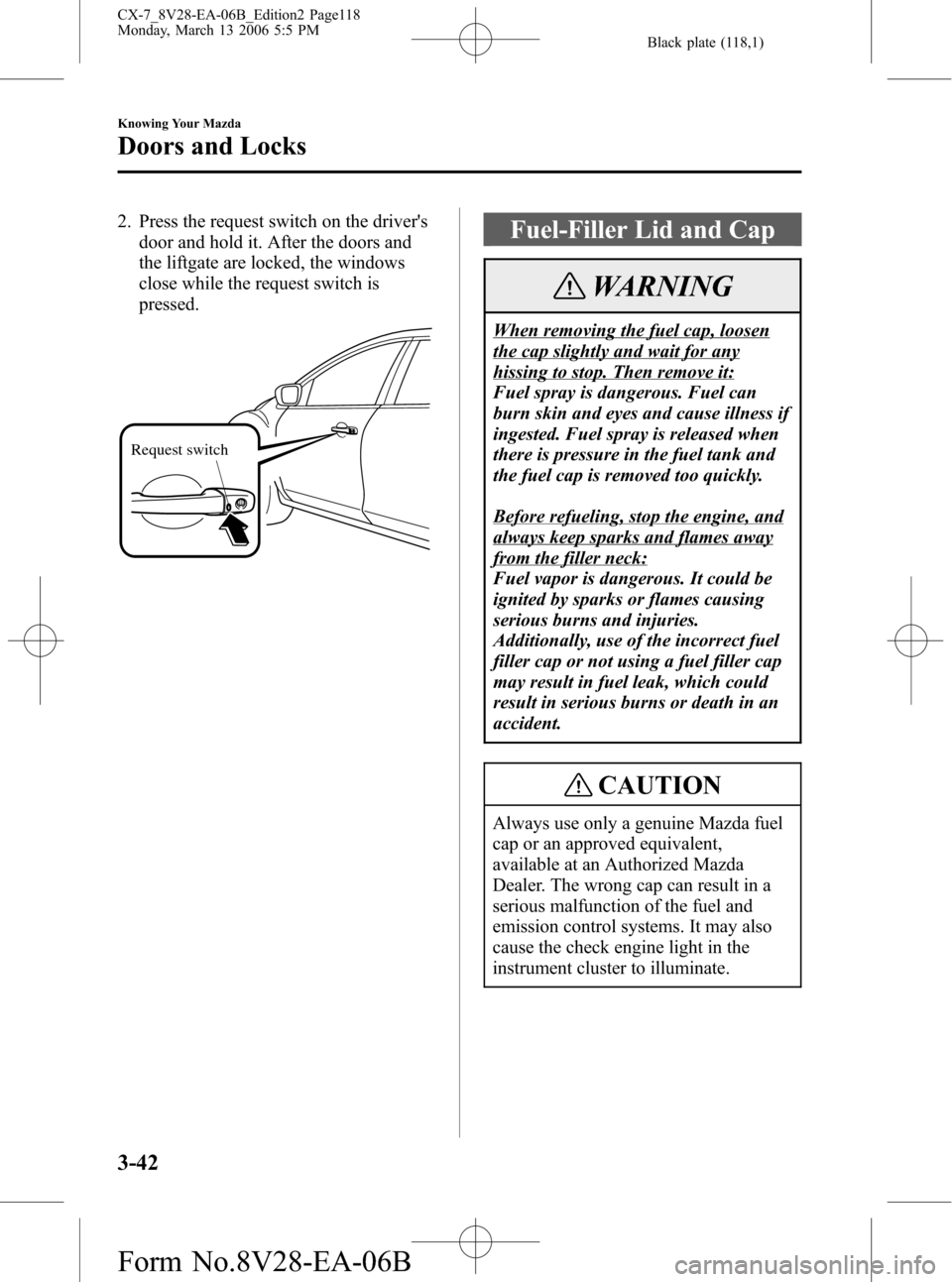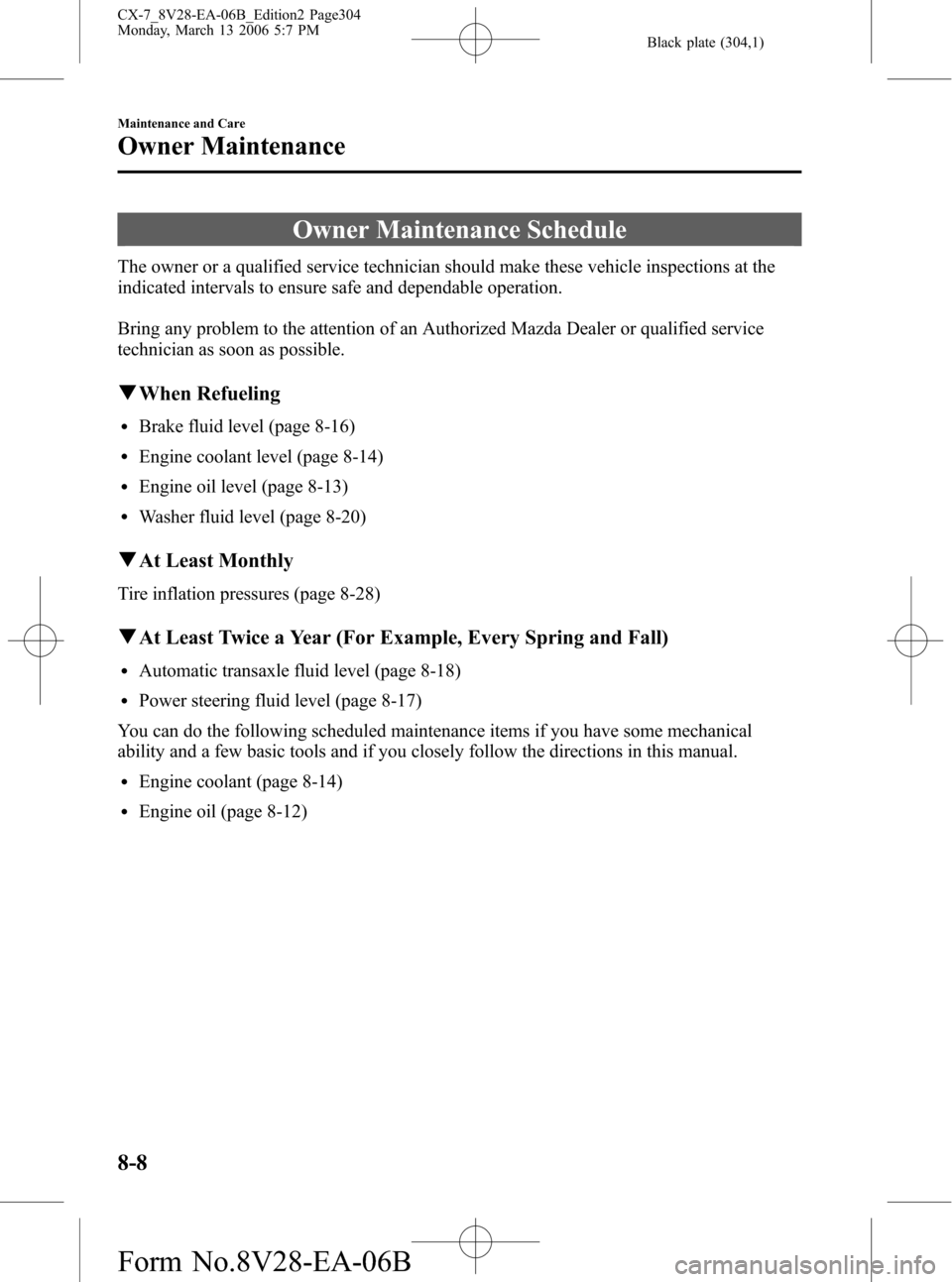2007 MAZDA MODEL CX-7 fuel pressure
[x] Cancel search: fuel pressurePage 118 of 406

Black plate (118,1)
2. Press the request switch on the driver's
door and hold it. After the doors and
the liftgate are locked, the windows
close while the request switch is
pressed.
Request switch
Fuel-Filler Lid and Cap
WARNING
When removing the fuel cap, loosen
the cap slightly and wait for any
hissing to stop. Then remove it:
Fuel spray is dangerous. Fuel can
burn skin and eyes and cause illness if
ingested. Fuel spray is released when
there is pressure in the fuel tank and
the fuel cap is removed too quickly.
Before refueling, stop the engine, and
always keep sparks and flames away
from the filler neck:
Fuel vapor is dangerous. It could be
ignited by sparks or flames causing
serious burns and injuries.
Additionally, use of the incorrect fuel
filler cap or not using a fuel filler cap
may result in fuel leak, which could
result in serious burns or death in an
accident.
CAUTION
Always use only a genuine Mazda fuel
cap or an approved equivalent,
available at an Authorized Mazda
Dealer. The wrong cap can result in a
serious malfunction of the fuel and
emission control systems. It may also
cause the check engine light in the
instrument cluster to illuminate.
3-42
Knowing Your Mazda
Doors and Locks
CX-7_8V28-EA-06B_Edition2 Page118
Monday, March 13 2006 5:5 PM
Form No.8V28-EA-06B
Page 148 of 406

Black plate (148,1)
Turbocharger Information
The turbocharger greatly enhances engine power. Its advanced design provides improved
operation and requires minimum additional maintenance. To get maximum performance
from your turbocharged engine, take note of the following tips:
lThe turbocharged engine is designed for optimal operation with premium unleaded
gasoline (page 4-2). Do not use fuel with a lower octane rating. Extra fuel additives are
NOT recommended.
lChange the engine oil and filter using the turbo engine interval outlined in the
maintenance schedule (for your driving condition).
lUse only the recommended engine oil (page 8-12). Extra oil additives are NOT
recommended.
lAfter driving at freeway speeds or up a long hill, idle the engine at least 30 seconds to
cool the turbo before turning off the engine. Avoid simply shutting the engine off
abruptly after a hard or long drive. Damage to the turbocharger may result.
lDon't race or over-rev the engine when starting. This should not be done with ANY
engine, especially not with one that's turbocharged.
lDo not add any aftermarket devices to alter the engine's ignition timing, fuel delivery, or
turbo boost pressure. This may lead to serious engine damage and may void your
warranty.
4-12
Before Driving Your Mazda
Driving Tips
CX-7_8V28-EA-06B_Edition2 Page148
Monday, March 13 2006 5:6 PM
Form No.8V28-EA-06B
Page 182 of 406

Black plate (182,1)
Tire Pressure Monitoring
System
í
The tire pressure monitoring system
(TPMS) monitors the pressure for each
tire.
If tire pressure is too low in one or more
tires, the system will inform the driver via
the warning light in the instrument panel
and by the warning beep sound.
The tire pressure sensors installed on each
wheel send tire pressure data by radio
signal to the receiver unit in the vehicle.
Tire pressure sensors
NOTE
When the ambient temperature is low
due to seasonal changes, tire
temperatures are also lower. If the tire
temperature lowers, the air pressure
lowers as well, and the TPMS warning
light illuminates more frequently.
Inspect the tire pressure dailybefore
driving, and check the tire pressures
monthly with a tire pressure gauge.
When checking the tire pressures, use
of a digital tire pressure gauge is
recommended.TPMS does not alleviate your need to
check the pressure and condition of all
four tires before you drive each day.
CAUTION
lEach tire, including the spare (if
provided), should be checked
monthly when cold and inflated to
the inflation pressure recommended
by the vehicle manufacturer on the
vehicle placard or tire inflation
pressure label. (If your vehicle has
tires of a different size than the size
indicated on the vehicle placard or
tire inflation pressure label, you
should determine the proper tire
inflation pressure for those tires.)
As an added safety feature, your
vehicle has been equipped with a tire
pressure monitoring system (TPMS)
that illuminates a low tire pressure
telltale when one or more of your
tires is significantly under-inflated.
Accordingly, when the low tire
pressure telltale illuminates, you
should stop and check your tires as
soon as possible, and inflate them to
the proper pressure. Driving on a
significantly under-inflated tire
causes the tire to overheat and can
lead to tire failure. Under-inflation
also reduces fuel efficiency and tire
tread life, and may affect the
vehicle's handling and stopping
ability.
Please note that the TPMS is not a
substitute for proper tire
maintenance, and it is the driver's
responsibility to maintain correct tire
pressure, even if under-inflation has
not reached the level to trigger
illumination of the TPMS low tire
pressure telltale.
5-26
Driving Your Mazda
íSome models.
Starting and Driving
CX-7_8V28-EA-06B_Edition2 Page182
Monday, March 13 2006 5:6 PM
Form No.8V28-EA-06B
Page 192 of 406

Black plate (192,1)
Warning/Indicator Lights
Warning/Indicator lights will appear in any of the highlighted areas
Signal Warning/Indicator Lights Page
Brake System Warning Light 5-38
Charging System Warning Light 5-39
Engine Oil Pressure Warning Light 5-40
Check Engine Light 5-40
ABS Warning Light 5-38
Air Bag/Front Seat Belt Pretensioner System Warning Light 5-41
Low Fuel Warning Light 5-41
5-36
Driving Your Mazda
Warning/Indicator Lights and Beep Sounds
CX-7_8V28-EA-06B_Edition2 Page192
Monday, March 13 2006 5:6 PM
Form No.8V28-EA-06B
Page 196 of 406

Black plate (196,1)
CAUTION
Don't continue driving when the
charging system warning light is
illuminated because the engine could
stop unexpectedly.
qEngine Oil Pressure Warning Light
This warning light illuminates when the
ignition switch is turned to the ON
position and turns off when the engine is
started.
This warning light indicates low engine
oil pressure.
If the light illuminates while driving:
1. Drive to the side of the road and park
off the right-of-way on level ground.
2. Turn off the engine and wait 5 minutes
for the oil to drain back into the oil
pan.
3. Inspect the engine oil level (page 8-13).
If it's low, add oil.
4. Check the warning light.
If the light remains illuminated even after
you add oil, have your vehicle towed to
an Authorized Mazda Dealer.
CAUTION
Don't run the engine if oil pressure is
low. It could result in extensive engine
damage.
qCheck Engine Light
If this light comes on while driving, the
vehicle may have a problem. It is
important to note the driving conditions
when the light came on and consult an
Authorized Mazda Dealer.
The check engine light may come on in
the following cases:
lThe fuel tank level being very low or
approaching empty.
lThe engine's electrical system has a
problem.
lThe emission control system has a
problem.
lThe fuel-filler cap is missing or not
tightened securely.
If the check engine light remains on or
flashes continuously, do not drive at high
speeds and consult an Authorized Mazda
Dealer as soon as possible.
5-40
Driving Your Mazda
Warning/Indicator Lights and Beep Sounds
CX-7_8V28-EA-06B_Edition2 Page196
Monday, March 13 2006 5:6 PM
Form No.8V28-EA-06B
Page 304 of 406

Black plate (304,1)
Owner Maintenance Schedule
The owner or a qualified service technician should make these vehicle inspections at the
indicated intervals to ensure safe and dependable operation.
Bring any problem to the attention of an Authorized Mazda Dealer or qualified service
technician as soon as possible.
qWhen Refueling
lBrake fluid level (page 8-16)
lEngine coolant level (page 8-14)
lEngine oil level (page 8-13)
lWasher fluid level (page 8-20)
qAt Least Monthly
Tire inflation pressures (page 8-28)
qAt Least Twice a Year (For Example, Every Spring and Fall)
lAutomatic transaxle fluid level (page 8-18)
lPower steering fluid level (page 8-17)
You can do the following scheduled maintenance items if you have some mechanical
ability and a few basic tools and if you closely follow the directions in this manual.
lEngine coolant (page 8-14)
lEngine oil (page 8-12)
8-8
Maintenance and Care
Owner Maintenance
CX-7_8V28-EA-06B_Edition2 Page304
Monday, March 13 2006 5:7 PM
Form No.8V28-EA-06B
Page 324 of 406

Black plate (324,1)
Tires
For reasons of proper performance, safety,
and better fuel economy, always maintain
recommended tire inflation pressures and
stay within the recommended load limits
and weight distribution.
WARNING
Using Different Tire Types:
Driving your vehicle with different
types of tires is dangerous. It could
cause poor handling and poor
braking; leading to loss of control.
Except for the limited use of the
temporary spare tire, use only the
same type tires (radial, bias-belted,
bias-type) on all four wheels.
Using Wrong-Sized Tires:
Using any other tire size than what is
specified for your Mazda (page 10-6)
is dangerous. It could seriously affect
ride, handling, ground clearance, tire
clearance, and speedometer
calibration. This could cause you to
have an accident. Use only tires that
are the correct size specified for your
Mazda.
qTire Inflation Pressure
WARNING
Incorrect Tire Inflation:
Overinflation or underinflation of tires
is dangerous. Adverse handling or
unexpected tire failure could result in
a serious accident. Always inflate the
tires to the correct pressure (page
10-6).
The Tire Pressure Monitoring System
í
does not alleviate the need to check the
tire condition every day, including
whether the tires all look inflated properly.
Inspect all tire pressure monthly
(including the spare) when the tires are
cold. Maintain recommended pressures
for the best ride, top handling, and
minimum tire wear.
When checking the tire pressures, use of a
digital tire pressure gauge is
recommended.
Except Canada (Tire pressure label)
8-28
Maintenance and Care
íSome models.
Owner Maintenance
CX-7_8V28-EA-06B_Edition2 Page324
Monday, March 13 2006 5:7 PM
Form No.8V28-EA-06B
Page 325 of 406

Black plate (325,1)
Canada (Motor vehicle safety standard
label)
Refer to the specification charts (page
10-6).
NOTE
lAlways check tire pressure when
tires are cold.
lWarm tires normally exceed
recommended pressures. Don't
release air from warm tires to adjust
the pressure.
lUnderinflation can cause reduced
fuel economy, uneven and
accelerated tire wear, and poor
sealing of the tire bead, which will
deform the wheel and cause
separation of tire from rim.
lOverinflation can produce a harsh
ride, uneven and accelerated tire
wear, and a greater possibility of
damage from road hazards.
Keep your tire pressure at the correct
levels. If one frequently needs
inflating, have it inspected.
qTire Rotation
To equalize tread wear, rotate the tires if
irregular wear develops. According to the
scheduled maintenance charts.Refer to
Scheduled Maintenance on page 8-3.
During rotation, inspect them for correct
balance.
Do not include (TEMPORARY USE ONLY)
spare tire in rotation.Forward
Also, inspect them for uneven wear and
damage. Abnormal wear is usually caused
by one or a combination of the following:
lIncorrect tire pressure
lImproper wheel alignment
lOut-of-balance wheel
lSevere braking
After rotation, inflate all tire pressures to
specification (page 10-6) and inspect the
lug nuts for tightness.
CAUTION
Rotate unidirectional tires and radial
tires that have an asymmetrical tread
pattern or studs only from front to rear,
not from side to side. Tire performance
will be weakened if rotated from side to
side.
Maintenance and Care
Owner Maintenance
8-29
CX-7_8V28-EA-06B_Edition2 Page325
Monday, March 13 2006 5:7 PM
Form No.8V28-EA-06B